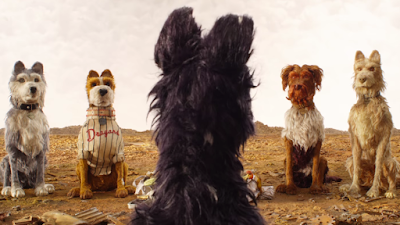I will be the first to admit I am a great fan of Wes Anderson. I can't think of another director today who's films essentially create their own genre. It takes only a few seconds to recognize the man's style - with its candy-colored mise-en-scene, the symmetry of shots, black humor, and dire situations. For all that is is, ISLE OF DOGS is not Anderson's most ambitious film, but I can't find a whole lot at fault to call it anything other than spectacular.
Isle of Dogs ("I love dogs?") is set in the not too distant Japanese future in which an outbreak of dog flu allows the Major of Megasaki City to banish all dogs to a nearby island that is also used as the city's dump. An opening scene depicts the passage of the law, the scientists who fight for funding to find a cure, etc. Compared to a lot of other Anderson films, there is a clear front-loading of exposition that sets up the story, our heroes, and uses no less than 3 translators and subtitles to get the point across.
Not long later, we meet our canine heroes, led by a stray named Chief (Bryan Cranston). He and his band of pets (all with appropriately strong named) encounter a young boy named Atari, the Mayor's ward who has stolen a small aircraft to go hunting for his long-lost dog, Spots. We recall Spots from the film's opening: a gentle white dog who is dropped onto Trash Island in a locked cage with no key. He had originally been given to the boy as a means of protection, and the two wear some sort of translator headset that allows for a modicum of communication. Chief, despite hesitation, agrees to assist the boy in his hunt.
The movie simultaneously follows those initial scientists on the mainland as they research a cure, and a young girl named Tracy (Greta Gerwig) who works to uncover the plot of the government to suppress information and ensure these dogs are brought back. Along the way, she begins to fall in love with Atari and his rebellious nature - of course being broadcast across TVs nationwide. I might have thought some of the story was dark for a "kids movie," only to remember some of the more horrific moments in the brilliant "Fantastic Mr Fox" or the undertones of war and genocide felt throughout The Grand Budapest Hotel.
I couldn't help but smile from opening credits to the final black screen. There is something so charming about this style of filmmaking that I can't help but believe it to be infectious. The animation style, which seems so perfectly fit with Wes Anderson's aesthetic, has a genuine charm that most computer-generated movies today seem to polish over. The individual hairs on each animal move with such imperfections, yet you can't help but be amazed at how much effort was clearly put into every frame. I have heard some criticisms about the movie's setting of Japan, about it's portrayal of the Japanese people, about casting white actors who speak English as the native dogs, etc. Where some of these complaints felt valid, I have to further the argument as to whether or not American dogs might not have English accents, or speak in a native Swahili dialect with their own canine intonations. It's a silly complaint, all the more silly for it revolving around cartoon dogs.
I can't state definitively that this is the quintessential Wes Anderson movie (I still feel partial to "Grand Budapest" and maybe even "Rushmore" for personal reasons), but for all it is worth, this is such a marvelous movie from beginning to end. It has been 4 years since the last Wes Anderson film was released, and with such quality as this, I wouldn't mind waiting even longer for his next movie. In terms of originality I can't think of many filmmakers as consistent as this.
OUR RATING SYSTEM
(*****) = do NOT miss! This one is as good as they come.
(****) = Fantastic - It's worth the price of the ticket (and then some).
(***) = Average - Nothing really bad, nothing really spectacular...
(**) = Perhaps you should find another movie to see.
(*) = The bottom of the barrel. It would be hard to find something less entertaining or more unworthy of your time.
(*****) = do NOT miss! This one is as good as they come.
(****) = Fantastic - It's worth the price of the ticket (and then some).
(***) = Average - Nothing really bad, nothing really spectacular...
(**) = Perhaps you should find another movie to see.
(*) = The bottom of the barrel. It would be hard to find something less entertaining or more unworthy of your time.
John (Jo) holds a Bachelor's Degree in Nursing, as well as a Bachelor of Arts degree in Film Studies. He currently lives in Chicago, Illinois and works as a nurse. His one true obsession in life is movies... The good, the bad, and everything in between. Other than that, he is busy caring for his cat, painting, writing, exploring Chicago, and debating on whether or not to worship Tilda Swinton as a deity. John is the master and commander and primary author of this blog.

No comments:
Post a Comment